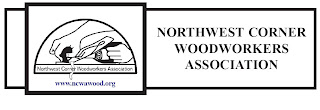Ok so here is how I made the bed knobs.
Yes it is poss

ible to buy them - but that is no fun.
I am also not talented enough to make them by free hand turning. Time for a jig!
Have a look at the picture and note the jig I made to pivot my router around the center of rotation on my lathe. The diameter of the ball is set by the hole I place the pivot bolt into and the depth I set on the router.
I start by mounting a block of wood to the faceplate on the lathe. Using a gouge I rough it to a cylinder that is slightly bigger than the ball diameter that I need. These where 4 inches. To give the router a break I knock off the end of the cylinder to a 45 degree - eyeballed to a level where I know it is not into the ball volume itself.
Ok so far?
Next, I set the jig pivot and router depth so that the end of a 1/2 inch dia straight bit is about 1/16th greater than the finsh diameter needed. Note the bit is fairly long - about 2 inches.
Move the jig at the arc position shown (zero degrees) up to the end of the cylinder and tighten the jigs clamp (not shown) to the lathe bedway.
Start the router while holding it in position. Start the lathe on a relatively slow RPM setting. Now slowly arc the router/jig on its pivot from 0 to 90 to the limit you can go on the jig before it is limited by the lathe head. This is the rough cut. Arc back and shut all down. Repeat another pass with the router dropped the remaining 1/16th for the final cut.

This is what the turning looks like after arcing the router.
After this stage I use a parting tool to reduce the shoulder down to a small cylinder. In this case it was about 2 inches about 1/2 inch long.

I drilled a hole in the top of the bed post of equal diameter to the cylinder I parted off at, glued the ball in place and thats it! All done other than cleaning up the chips. Balls of fun! Till next time - Cheers.
 It is amazing how a chair is transformed from "just wood" to being a comfortable place to sit and relax once the upholstering is done. This has been my morning coffee chair for the past while. I have to compete with my wife for its use in the evening. It seems to be perfect for sitting and spinning wool as she loves to do. It is also the chair that draws people like a magnet when they come to visit.
It is amazing how a chair is transformed from "just wood" to being a comfortable place to sit and relax once the upholstering is done. This has been my morning coffee chair for the past while. I have to compete with my wife for its use in the evening. It seems to be perfect for sitting and spinning wool as she loves to do. It is also the chair that draws people like a magnet when they come to visit.








